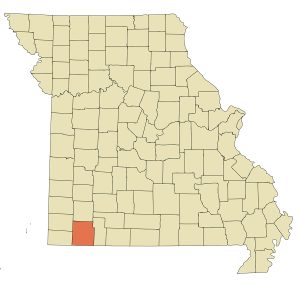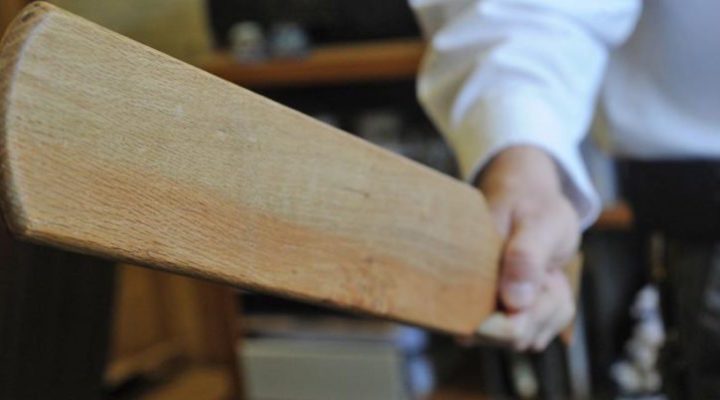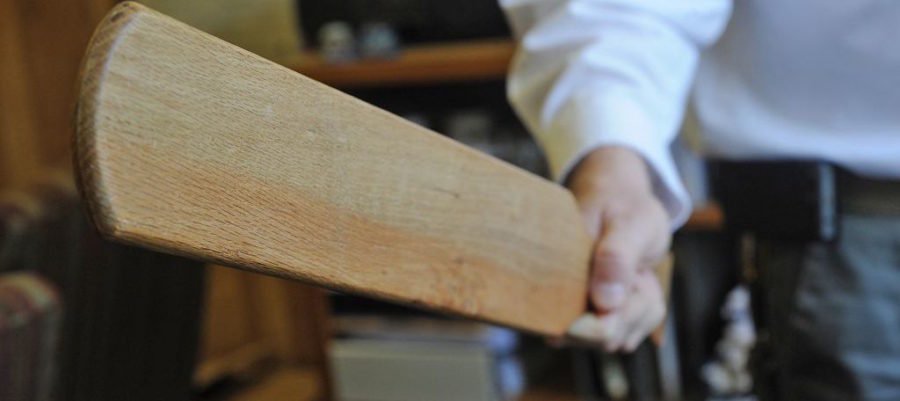“Make education violent again” seems to be the slogan for a public school district in Missouri.
The Cassville School District decided on June 16, 2022, to bring back spanking after parents requested for the schools to spank their kids.

Merlyn Johnson
In a scene reminiscent of Pontius Pilate washing his hands and blaming the people, Superintendent Merlyn Johnson told the Springfield News-Leader, “Parents have said, ‘Why can’t you paddle my student?’ And we’re like ‘We can’t paddle your student,’ our policy does not support that.’”
Yet the superintendent went along with the parents’ desire to change the policy, allowing school officials to hit kids by “swatting the buttocks with a paddle” with up to three swings.
“It is something that has happened on my watch and I’m OK with it.”
Johnson said: “My plan, when I came to Cassville, wasn’t to be known as the guy who brought corporal punishment back to Cassville. I didn’t want that to be my legacy and I still don’t. But it is something that has happened on my watch and I’m OK with it.”
The policy defines corporal punishment as “the use of physical force as a method of correcting student behavior.” It requires that “corporal punishment shall be administered only by certified personnel and in the presence of a witness who is also an employee of the district.”
It is unclear who “certified” spanking personnel would be. Will they undergo spanking training or have a spanking test they have to pass? Will it be a written exam or will the administrators be tested by spanking each other? Will they be identified with a spanking badge? And will their spanking certification expire at some point and have to be renewed?
In an attempt to sound reasonable, the policy states, “Striking a student on the head or face is not permitted.”
The response from the parents for reinstating spanking after more than two decades has been mostly rejoicing. Johnson said: “We’ve had people actually thank us for it. Surprisingly, those on social media would probably be appalled to hear us say these things but the majority of people that I’ve run into have been supportive.”
Miranda Waltrip, who is a parent of three children in the district, is not among those rejoicing.
“We live in a really small community where people were raised a certain way, and they’re kind of blanketed in that fact that they grew up having discipline and swats. And so, for them, it’s like going back to the good old days.”
Loss of bodily autonomy and consent
Of course, the “good old days” also were the days when people were generally unaware of the need for bodily autonomy and consent. While the policy requires “a parent or guardian being notified and providing written permission for the corporal punishment,” nowhere does it mention asking the kids if adults have their permission to hit them. They have lost their bodily autonomy. And they’ve given no consent to be hit by adults.
“They’ve given no consent to be hit by adults.”
Kalia Miller and Gabe Moore, who are seniors at Cassville High School, are organizing a protest that already has more than 100 classmates involved. Moore told the News-Leader: “Most students are scared, the fact that they’ll be hit by a 30- or 40-year-old man, and mostly women, are scared that they’ll be spanked or hit by a man with another guy in the room and they would feel embarrassed or see it as a call-back to trauma. … It’s really frightening for a lot of students. Some students see it as abuse, and it is abuse.”

Kalia Miller
Miller added parents are saying that spanking was “a punishment used on them in school and should be brought back because it’s what they went through.” But to Miller: “This policy is demeaning. It diminishes us as humans, as people. It is just not an efficient or successful way to deal with these behaviors that they say students deserve to be punished for or hit over.”

Gabe Moore
Moore noted the new policy undermines what the school has been teaching about consent. “It doesn’t really matter if the parents are for this policy because the students should have to consent if they are going to get hit or not. Parents are opting in for their child to get abused,” he said.
An extremely white and ‘very traditional community’
Johnson, the superintendent, called Cassville a “very traditional community.” And the demographics bear that out. According to the 2020 Census, Cassville’s Barry County has a population of 34,534 — made up of 94.09% white, 5.04% Hispanic or Latino, and 0.11% Black or African American residents.
In 2020, voters in Barry County went for Trump over Biden in a 79% to 19% margin and overwhelmingly supported Josh Hawley for U.S. Senate.

Barry County, Missouri
Despite its small population, there are 30 churches listed within an 8-minute drive from the center of Cassville. And according to the Association of Religion Data Archives, 50% of Barry County residents identify as Southern Baptists, 19% identify as Catholics and 5% identify as Methodist.
A history of spanking in schools
Children have been spanked in American schools for hundreds of years. New Jersey prohibited spanking in public schools in 1867, becoming the first state to do so. It wasn’t until 1972 that another state — Massachusetts — joined in with a similar ban. Despite these bans, the United States Supreme Court ruled in 1977 in Ingraham v. Wright that spanking in public schools was constitutional.
Spanking in public schools remains legal in 19 states. It also is legal in private schools in every state other than New Jersey and Iowa.
The 19 states where public school personnel are allowed to spank children from preschoolers to high school seniors are Alabama, Arkansas, Arizona, Colorado, Florida, Georgia, Idaho, Indiana, Kansas, Kentucky, Louisiana, Missouri, Mississippi, North Carolina, Oklahoma, South Carolina, Tennessee, Texas and Wyoming.
“Children with disabilities were more likely to be spanked than their peers.”
According to the U.S. Department of Education’s Civil Rights Data Collection, more than 110,000 students “were subject to corporal punishment in school during the 2013-2014 academic year.” Of the students who were spanked, 36% were Black, despite Black students making up only 16% of the student population. Black boys were 1.8 times more likely than white boys, and Black girls were 2.9 times more likely than white girls to be spanked. Additionally, children with disabilities were more likely to be spanked than their peers.
If that is what is being tracked in public schools, imagine what isn’t being tracked in private Christian schools. According to the Government Accountability Office, these figures are “significantly understated.” Even as recently as 2017-2018, more than 69,000 students were reported to have been spanked at school across the country.
The impact of physical punishment on our bodies
Many of us have heard parents say, “This is going to hurt me more than it’s going to hurt you” prior to lighting into our backside. I grew up being spanked with hands, belts, ping pong paddles, wooden spoons and wooden rubber band guns. When I was 7, my teacher would slap me hard across the face and under the chin in the middle of the classroom for getting a bad grade on a quiz, and she continued doing so until I stopped crying. She also took me into a janitorial closet, shut the door behind her, told me to pull my pants down and to bend over while she spanked me. The pain of the spanking was harsh. But the most embarrassing part of it was having my teacher see me in my underwear.
Whatever method adults use to hit kids, the reality is that adults hitting kids has a deeply negative impact on their mental, spiritual and physical health.
“Whatever method adults use to hit kids, the reality is that adults hitting kids has a deeply negative impact on their mental, spiritual and physical health.”
According to the American Academy of Pediatrics, “Harsh physical punishment was associated with increased odds of mood disorders, anxiety disorders, alcohol and drug abuse/dependence, and several personality disorders after adjusting for sociodemographic variables and family history of dysfunction.”
In a study about the relationship between physical punishment and mental disorders, the AAP concluded that physical punishment was “associated with mood disorders, anxiety disorders, substance abuse/dependence, and personality disorders in a general population sample. These findings inform the ongoing debate around the use of physical punishment and provide evidence that harsh physical punishment independent of child maltreatment is related to mental disorders.”
We now know that the way children are nurtured can affect not only their minds and bodies, but also their DNA.
Harvard University’s Center on the Developing Child did a study about epigenetics that showed how the DNA we inherit from our parents receives “chemical marks that determine how much or little of the genes is expressed. … The different experiences children have rearrange those chemical marks. This explains why genetically identical twins can exhibit different behaviors, skills, health and achievement.” It found that environmental toxins or stress can negatively affect children’s DNA and that younger children are especially vulnerable to epigenetic adaptations in their DNA that affect “future capacity for health, skills and resilience.”
A white supremacist fueled violence
No community has felt the effects of this violence as deeply as African Americans. Just as Black children are two to three times more likely to be spanked at school, a study by the Pew Research Center shows that Black children are more than twice as likely to be spanked at home than white children.
Stacey Patton is an assistant professor of multimedia journalism at Morgan State University and the author of Spare the Kids: Why Whupping Children Won’t Save Black America. In an article for the American Psychological Association, she explored how the practice of corporal punishment in Black communities has its roots in racial trauma.
“African Americans adopted the practice of beating children from white slave masters,” she wrote. “Europeans brutalized their own children for thousands of years prior to crossing the Atlantic to the New World and colonizing Africa. Historians and anthropologists have found no evidence that ritualistic forms of physical discipline of children existed in precolonial West African societies prior to the Atlantic slave trade. … As colonization, slavery and genocidal violence made life harsher for these groups, parenting practices also grew harsher.
“With sanctioning from the Black church, Black parents enacted the master’s lash to instill obedience.”
“Once in America, slaves as parents were under tremendous pressure to shape their children into docile field workers and to teach them proper deference and demeanor in front of whites,” Patton added. “After slaves were emancipated in 1865, yet still not free, the rules of racial etiquette and the ritualistic beatings continued as a new kind of coercive Southern labor system emerged that depended on Black child workers. Once again, whites co-opted Black parenting to make sure it performed the same kind of function in freedom that it had during slavery. With sanctioning from the Black church, Black parents enacted the master’s lash to instill obedience.”
The reason Black families have struggled with intergenerational trauma has nothing to do with John MacArthur’s white supremacist interpretation of the Curse of Ham or with the promoters of eugenics interpretation of the curse in Exodus 20. It has everything to do with the trauma inflicted on Black bodies at the hands of white hierarchies.
Spare the rod, spoil the child
It’s time for white Americans to get real about their propagation of violence toward children that has caused centuries of racial trauma for Black communities through the promotion of spanking.
 According to a study published in Pastoral Psychology in 2008: “Theological conservatism is unrelated to corporal punishment attitudes, but political conservatism and Republican Party leanings are strongly predictive of greater approval of physical discipline; and clergy members who know someone in their congregation who has experienced abuse are less supportive of the corporal punishment of children.”
According to a study published in Pastoral Psychology in 2008: “Theological conservatism is unrelated to corporal punishment attitudes, but political conservatism and Republican Party leanings are strongly predictive of greater approval of physical discipline; and clergy members who know someone in their congregation who has experienced abuse are less supportive of the corporal punishment of children.”
While some theological conservatives interpret “the rod” in Proverbs 13:24 and Proverbs 23:13-14 as a literal command to strike their children with wood, others interpret it as a metaphor for discipline. Progressives tend to opt for the metaphorical interpretation.
Given the fact that the ancient Near Eastern culture saw physical beating as normal and that the Hebrew Bible commanded stoning children, as well as stoning wives and chopping off their hands while showing no pity, it seems a bit odd to assume the author of Proverbs simply meant for striking your child with a rod to be taken metaphorically.
So rather than assuming that the Bible was meant to be taken metaphorically about spanking when it commands physical violence far more damaging elsewhere, what if we asked ourselves if these passages are our best resource for liberating children, or if we might have some better resources available to us today?
Liberate the children
Clarissa W. Atkinson shares the story of corporal punishment in some of the earliest North American schools in her essay “‘Wonderful Affection’: Seventeenth-Century Missionaries to New France on Children and Childhood.”
While the French Jesuits talked of their “single, burning intention to bring souls to Christ,” their method for doing so was to take the Huron children away from their parents so they could educate the children under the threat of corporal punishment.
In one instance, while the Jesuits were whipping a child, a Huron man offered to be beaten instead. Nobody deserved to be beaten, despite what the child had done. But when an educational system demanded that a child be hit, it was someone the Jesuits called a “barbarian” and a “savage” who did what it took to liberate the child from violence.
“Isn’t it time we stop using religion to justify violence?”
We’ve been hitting kids in North American schools for 400 years now. Isn’t it time we stop using religion to justify violence?
As child liberationist theologian R.L. Stollar reflected: “The Huron, not the Jesuits, ‘took up our pain and bore our suffering’ (Isaiah 53:4). In sacrificing himself for the child’s sin, the Huron man was more of an example of Jesus than any of the Jesuits who stood ready to ‘cast stones’ upon the child.”
Rick Pidcock is a 2004 graduate of Bob Jones University, with a Bachelor of Arts degree in Bible. He’s a freelance writer based in South Carolina and a former Clemons Fellow with BNG. He recently completed a Master of Arts degree in worship from Northern Seminary. He is a stay-at-home father of five children and produces music under the artist name Provoke Wonder. Follow his blog at www.rickpidcock.com.
Related articles:
Spankings of member’s child earn Baptist pastor battery conviction
Remembering Jamorio and praying for justice | Opinion by Chris Conley
The seeds of evangelical angst over gender and sex were sown decades ago


